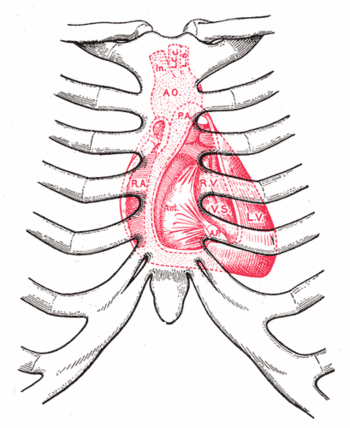Heart murmur: Difference between revisions
imported>Robert Badgett No edit summary |
imported>Robert Badgett (→Aortic stenosis: Moved content to more specific article) |
||
| Line 28: | Line 28: | ||
A [[systematic review]] by the [http://jama.ama-assn.org/cgi/collection/rational_clinical_exam Rational Clinical Examination] addresses the diagnosis of systolic murmurs.<ref name="pmid9032164">{{cite journal |author=Etchells E, Bell C, Robb K |title=Does this patient have an abnormal systolic murmur? |journal=JAMA : the Journal of the American Medical Association |volume=277 |issue=7 |pages=564–71 |year=1997 |month=February |pmid=9032164 |doi= |url= |issn=}} [http://ovidsp.ovid.com/ovidweb.cgi?T=JS&PAGE=linkout&SEARCH=9032164.ui Full text at OVID]</ref> | A [[systematic review]] by the [http://jama.ama-assn.org/cgi/collection/rational_clinical_exam Rational Clinical Examination] addresses the diagnosis of systolic murmurs.<ref name="pmid9032164">{{cite journal |author=Etchells E, Bell C, Robb K |title=Does this patient have an abnormal systolic murmur? |journal=JAMA : the Journal of the American Medical Association |volume=277 |issue=7 |pages=564–71 |year=1997 |month=February |pmid=9032164 |doi= |url= |issn=}} [http://ovidsp.ovid.com/ovidweb.cgi?T=JS&PAGE=linkout&SEARCH=9032164.ui Full text at OVID]</ref> | ||
====Aortic | ====Aortic valve stenosis==== | ||
{{main|Aortic valve stenosis}} | |||
===Diastolic murmurs=== | ===Diastolic murmurs=== | ||
Revision as of 00:52, 7 November 2008
In medicine, heart murmurs are the "heart sounds caused by vibrations resulting from the flow of blood through the heart. Heart murmurs can be examined by heart auscultation, and analyzed by their intensity (6 grades), duration, timing (systolic, diastolic, or continuous), location, transmission, and quality (musical, vibratory, blowing, etc)."[1]
| Valve | Severity | Prevalence | |
|---|---|---|---|
| Males | Females | ||
| Mitral[2] | > mild | 13% | 9% |
| Tricuspid[2] | > mild | 19 | 19 |
| Aortic[2] | > mild | 15 | 18 |
| Aortic stenosis[3] | Valve velocity > 2.0 m/s | 2 | 1 |
| Aortic sclerosis[3] | 33 | 25 | |
A diagram of the cardiac cycle is available and helps understand where to listen for different heart murmurs.[4]
Classification
Systolic murmurs
A systematic review by the Rational Clinical Examination addresses the diagnosis of systolic murmurs.[5]
Aortic valve stenosis
Diastolic murmurs
Indications for echocardiography
Indications for echocardiography have been formulated by clinical practice guidelines of the American College of Cardiology and the American Heart Association:[6] Class I recommendations
- "Echocardiography is recommended for asymptomatic patients with diastolic murmurs, continuous murmurs, holosystolic murmurs, late systolic murmurs, murmurs associated with ejection clicks or murmurs that radiate to the neck or back."
- "Echocardiography is recommended for patients with heart murmurs and symptoms or signs of heart failure, myocardial ischemia/infarction, syncope, thromboembolism, infective endocarditis, or other clinical evidence of structural heart disease."
- "Echocardiography is recommended for asymptomatic patients who have grade 3 or louder midpeaking systolic murmurs."
Class IIa recommendations
- "Echocardiography can be useful for the evaluation of asymptomatic patients with murmurs associated with other abnormal cardiac physical findings or murmurs associated with an abnormal ECG or chest X-ray."
- "Echocardiography can be useful for patients whose symptoms and/or signs are likely noncardiac in origin but in whom a cardiac basis cannot be excluded by standard evaluation."
Class III recommendations
- "Echocardiography is not recommended for patients who have a grade 2 or softer midsystolic murmur identified as innocent or functional."
Auscultation
Murmurs may be graded by their loudness:[7]
- Grade I - not heard immediately
- Grade II - heard immediately
- Grade III - hear immediately, but louder
- Grade IV - associated with palpable thrill
- Grade V - may be heard with stethoscope partially off the chest
- Grade VI - may be heard with stethoscope off the chest
References
- ↑ Anonymous (2024), Heart murmur (English). Medical Subject Headings. U.S. National Library of Medicine.
- ↑ 2.0 2.1 2.2 2.3 Singh JP, Evans JC, Levy D, et al (March 1999). "Prevalence and clinical determinants of mitral, tricuspid, and aortic regurgitation (the Framingham Heart Study)". The American journal of cardiology 83 (6): 897–902. PMID 10190406. [e]
- ↑ 3.0 3.1 3.2 Otto CM, Lind BK, Kitzman DW, Gersh BJ, Siscovick DS (July 1999). "Association of aortic-valve sclerosis with cardiovascular mortality and morbidity in the elderly". The New England journal of medicine 341 (3): 142–7. PMID 10403851. [e]
- ↑ (1990) “The First Heart Sound”, Walker HK, Hall WD, Hurst JW: Clinical methods: the history, physical, and laboratory examinations (in English), 3rd. London: Butterworths. LCC RC71 .C63. ISBN 0-409-90077-X. “See image of cardiac cycle at http://www.ncbi.nlm.nih.gov/bookshelf/br.fcgi?book=cm&partid=333&rendertype=figure&id=A684” Library of Congress
- ↑ Etchells E, Bell C, Robb K (February 1997). "Does this patient have an abnormal systolic murmur?". JAMA : the Journal of the American Medical Association 277 (7): 564–71. PMID 9032164. [e] Full text at OVID
- ↑ Bonow RO, Carabello BA, Kanu C, de Leon AC Jr, Faxon DP, Freed MD, Gaasch WH, Lytle BW, Nishimura RA, O'Gara PT, O'Rourke RA, Otto CM, Shah PM, Shanewise JS, Smith SC Jr, Jacobs AK, Adams CD, Anderson JL, Antman EM, Faxon DP, Fuster V, Halperin JL, Hiratzka LF, Hunt SA, Lytle BW, Nishimura R, Page RL, Riegel B.ACC/AHA 2006 guidelines for the management of patients with valvular heart disease: a report of the American College of Cardiology/American Heart Association Task Force on Practice Guidelines (writing committee to revise the 1998 Guidelines for the Management of Patients With Valvular Heart Disease): developed in collaboration with the Society of Cardiovascular Anesthesiologists: endorsed by the Society for Cardiovascular Angiography and Interventions and the Society of Thoracic Surgeons.Circulation. 2006 Aug 1;114(5):e84-231. PMID 16880336 (see page 462 for indications for replacement)
- ↑ McGee, Steven R. (2007). “Heart Murmurs: General Principles”, Evidence-Based Physical Diagnosis. Philadelphia: Saunders, 456. ISBN 1-4160-2898-6.
Bibliography
- Drummond Rennie; David Simel (2008). THE RATIONAL CLINICAL EXAMINATION: EVIDENCE-BASED CLINICAL DIAGNOSIS (Jama & Archives Journals). McGraw-Hill Professional. ISBN 0-07-159030-7.
- McGee, Steven R. (2007). Evidence-Based Physical Diagnosis. Philadelphia: Saunders. ISBN 1-4160-2898-6.
- (1990) Walker HK, Hall WD, Hurst JW: Clinical methods: the history, physical, and laboratory examinations (in English), 3rd. London: Butterworths. LCC RC71 .C63. ISBN 0-409-90077-X. Library of Congress
